Hub Sizes
Old Frames and Forks/New PartsOver the last 40 years, bicycle drivetrains have improved immensely. Indexing has taken much of the guesswork out of shifting; integrated brake/shifters such as Campagnolo's Ergo and Shimano's STI have brought the ability to shift without removing a hand from the handlebars; lower gears help older riders get up the tough hills that didn't bother them when they were younger. Internal-gear hubs are available with more speeds. While drivetrains have improved, frames have not, and in many ways, they've changed for the worse! Older frames designed for touring or recreational riding are often considerably more comfortable and pleasant to ride than many modern frames that have been optimized to appeal to racers. Older frames have room for wider tires, and for fenders, making them more practical for those who are not just fair-weather cyclists. Then again, you may have an older bike that you've just become sentimentally attached to...it's not hard to bond to a bike that has carried you for thousands of happy miles. If you have a beloved older bike, but are not enjoying its antiquated shifting system, it isn't unreasonable to upgrade it with a new rear wheel, derailers and shifters (or internal-gear hub). There's one fly in the ointment, however...will the new wheel fit into the old frame? Often, the answer is "no," because newer hubs are wider, with longer axles, than the older ones. ..But you don't need to take no for an answer! Older frames, assuming they're made of some sort of steel, can be modified to fit. The process is commonly referred to as "cold setting" which is a fancy way of saying bending the rear frame apart so that it is wider. This article tells you how. An older front fork also may need spreading to fit a modern hub. This is the case with forks of older Raleigh three-speed bicycles and many older French frames. If you're not sure whether your frame or fork is steel or not, the easy way to tell is to see if a magnet sticks to it. If it does, the frame is steel, and can be cold set. SpacingA bicycle frame and fork should match the wheels that are to be used in it. Older bicycles used narrower spacing, but older frames can often be spread out to match more modern wheels. The spacing of a frame/fork is measured from the inside surfaces of the forkends (dropouts), where they come into contact with the locknuts of the wheel's axle.
This frame has a spacing of 125 mm
This hub has an O.L.D. of 135 mm
Some standard spacings:As of 2018, fatbikes and disk brakes have led to a several new axle-length standards. The problem of disk brakes' pulling the hub out of the front dropouts (see James Annan's article) has been addressed with through axles, which insert into a fork with a hole rather than a slot at the end of each blade. Also see our article about disc brakes for information on disc-brake issues.
The page on chainline of internal-gear hubs gives overlocknut dimensions of these hubs. When in doubt, measure! Overall axle length for quick release hubs is commonly 11 mm longer than the overlocknut distance listed, 5.5 mm on each side. In practice, the axle can be quite a bit shorter than this...even 1-2 mm protrusion past the lock nuts will suffice to locate the axle properly, so, when converting a hub to the next wider spacing, it is usually unnecessary to replace the axle. Axle Spacing AdjustmentHubs with conventional threaded axles can be adjusted for wider spacing by adding spacer washers, preferably between the cones and the locknuts. For single-sprocket wheels, it is generally best to add equal spacers to each side. This way, the rim remains centered in the frame. With most internal-gear hubs, spacers can be added on the left end of the axle, and with some also on the right, as described on the page that gives their overlocknut distances. If you are increasing the spacing of a derailer-type wheel for the purpose of increasing the number of sprockets, you'll generally be adding space to the right side only. If you do this, you'll need to "re-dish" the wheel, by pulling the rim to the right. This is done by tightening the spokes on the right side of the wheel and/or loosening those on the left side. If you don't have experience with wheel trueing, this may be a job you're not yet ready for. The downside of this is that pulling the rim to the right increases the tension difference between the left and right spokes, resulting in a somewhat weaker wheel. Conversely, if you're installing a wheel in a wider frame than it was meant for, adding the spacers to the left side will allow you to increase the strength of the wheel by moving the rim to the left. Axle LengthTypical quick-release axles are 11 or 12 mm longer than the spacing of the hub locknuts. This gives 5.5-6 mm of axle protrusion on each side. You don't actually need nearly this much, so for respacing hubs to wider spacing, if you're not adding more than, say, 5-6 mm of spacers, you don't need a new axle. As long as you have 2 or 3 mm sticking out on each side, that's plenty.One of my own bikes is set up with the axle cut off flush with the locknuts, and even this is no problem in use, though it is slightly trickier to align the wheel when installing it. See my page about my fixed-gear mountain bikes. Frame/Fork Spacing AdjustmentIf your frame or fork is made of steel, you can change the spacing to accommodate different hub spacing. This is most commonly done to widen the spacing, to permit the use of a cluster with more sprockets than the frame was built for. Note, if you're not careful, you can do serious damage to your frame or fork this way! If your frame or fork is made of aluminum or carbon fiber, do not attempt to re-space it: these materials are not suitable for "cold setting." If in doubt, try the magnet test: if a magnet won't stick to it, don't try to re-space it!
Do You Need To Permanently Spread Your Frame?Ideally, the frame spacing should exactly match the hub spacing. This makes for easiest wheel replacement. In practice, however, there's a fair amount of latitude in fit. In fact, when the first 130 mm 8-speed hubs were introduced, they had locknuts with beveled sides, so that you could "spring" apart the rear triangle of a frame made for the then-standard 126 mm spacing. A conventional cup-and-cone hub tolerates some bearing misalignment, and in general, you can safely go up one size in spacing this way, just springing the frame apart. I can't give you an absolute guarantee that this won't cause damage, but the odds are very much in your favor. Having to spring the frame every time you replace the wheel is inconvenient, especially if it has a quick-release axle .An internal-gear hub or sealed-bearing hub is very likely to be damaged if the dropouts are not parallel. In this case, cold setting is the better way to go. If you're going up more than one size, say from 120 to 130, or from 126 to 135, you should definitely cold set the frame. Spreading the FrameThere are a number of ways to do spread a frame. Probably the easiest way is to use a lever. A piece of 2 x 3 or 2 x 4 lumber, roughly 5-6 feet long works well for this:
Spreading a Front ForkA front fork can't be spread the same way as the rear of a frame, because you can't lever against the seat tube. Generally, the front fork is spread by pulling the blades apart from one another. Better-equipped bike shops have jigs to align fork blades. This can be done with a hub axle, placing axle nuts in between the fork blades. Fine adjustments may be made with a rubber mallet.
Checking Alignment (Symmetry)It is important that both forkends be equally far from the centerline of the frame or fork, otherwise the bicycle won't track properly. Ideally, the frame alignment should be made using a special fixture that clamps the frame by the sides of the bottom bracket shell, and takes those faces as the reference point for all other measurements. This requires special tooling beyond the reach of the home mechanic or small bike shop. Assuming that a frame was built straight to begin with, alignment can be checked by comparison of the rear triangle with the front triangle. Park makes an adjustable gauge for this, the FAG-2, and this is what most bike shops would use. The usual "home mechanic" technique, however requires nothing more than a piece of string and a ruler. This is a bit slower than using a purpose-built gauge, but gives good results, if you are reasonably careful. The String Method:
Checking a front forkA bike shop checks symmetry of a front fork with its special jig, but symmetry can also be checked roughly by installing a wheel into the fork and testing whether the rim centers between the fork blades. To be sure that the wheel itself is centered, turn it over and try it the other way. The rim should be the same distance from each fork blade after being turned over. Minor adjustments for symmetry can be made with a rubber mallet. Testing for symmetry of a front fork is more difficult than with the rear of a frame.
Forkend Alignment (Parallelism)Spreading a frame or fork will cause a slight change in the angles of the forkends, so they will no longer be exactly parallel to one another (assuming they started that way.) Check for parallelism after spreading a frame or fork, or whenever you are concerned that forkends might be out of parallel -- if the bicycle has been crashed, a forkend is visibly bent, or a wheel is hard to install and an axle nut or quick release feels "springy" rather than clamping down tight. Procedures for checking and adjusting parallelism have been moved to another page. Should You Try This?This job isn't for everybody, but it's not rocket science either. Many shops are reluctant to undertake this sort of operation, either because of fear of liability or because they want to sell you new bike. Although it seems fairly alarming to deliberately bend your frame, it is really not that cataclysmic an operation, and can be very worthwhile if it allows you to keep riding an old friend, with the advantages of a modern drivetrain.
Articles by Sheldon Brown and Others
Reports of the demise of this Web site are greatly exaggerated! We at sheldonbrown.com thank Harris Cyclery for its support over the years. Harris Cyclery has closed, but we keep going. Keep visiting the site for new and updated articles, and news about possible new affilations.Copyright © 2001, 2008 Sheldon BrownHarris Cyclery Home PageIf you would like to make a link or bookmark to this page, the URL is:https://www.sheldonbrown.com/frame-spacing.html Last Updated: 09/08/2021 06:49:54 by John Allen | |||||||||||||||||||||||||||||||||||||||||
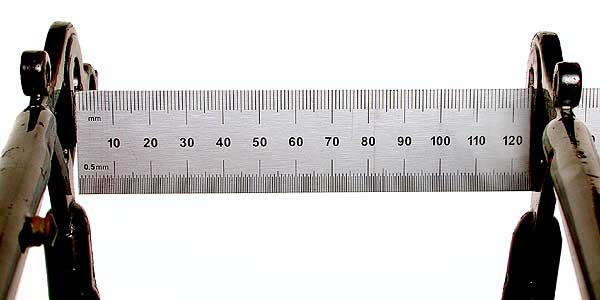



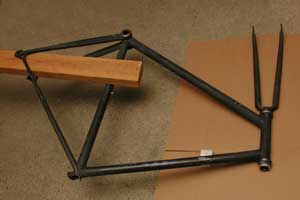
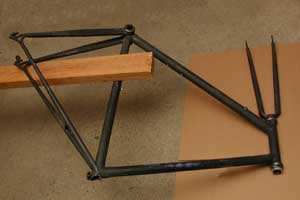
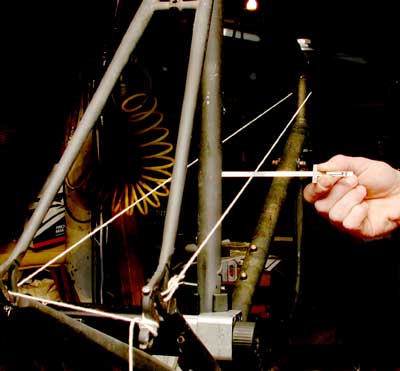

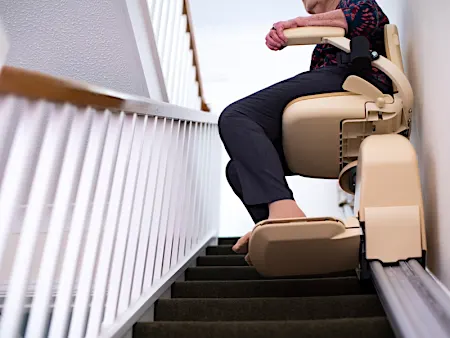



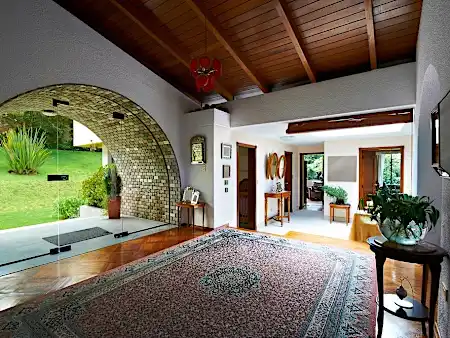


Comments
Post a Comment